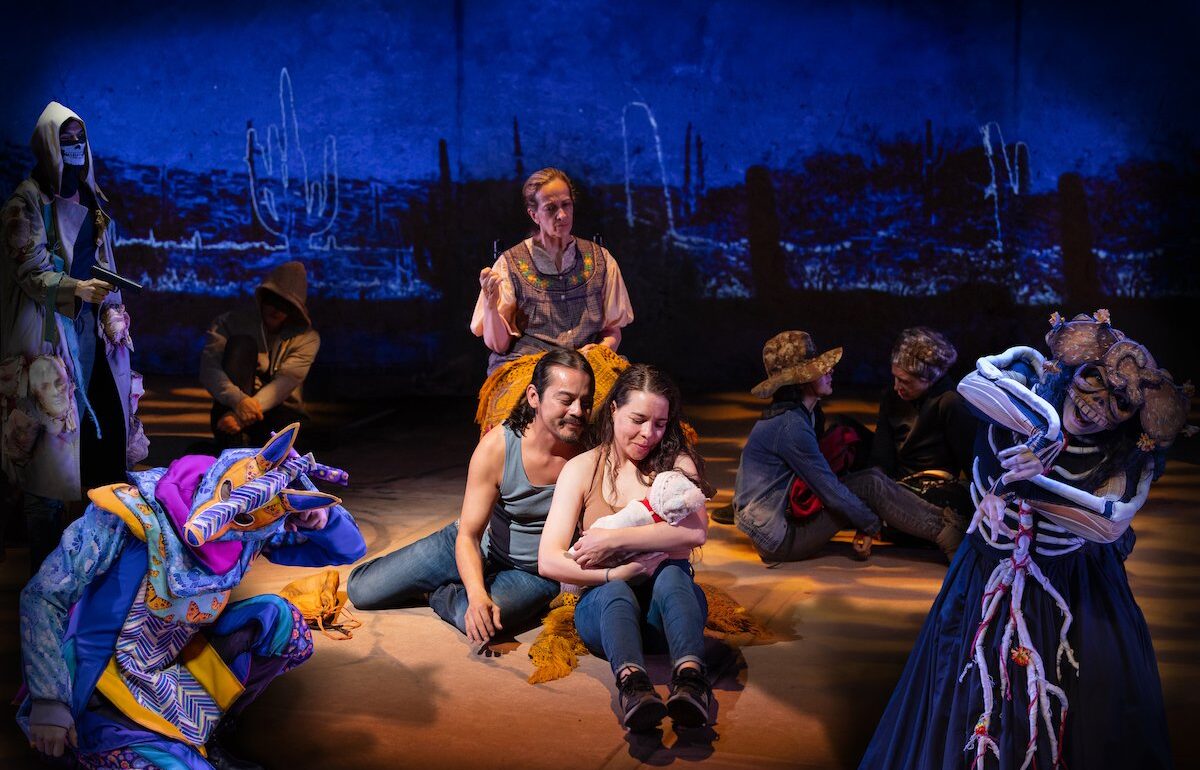I don’t want to write today. On Nov. 6 my body lingered numb under a blanket. I needed to rise for Encuentro with ánimo, yet I didn’t want to dream. Outside, the California mountains whispered memories of Dolores Huerta and her calls of resistance: Sí, se puede. The rolling roads seemed to echo a zapateado with nature. Arriving the next day at the Los Angeles Theatre Center’s Greek Revival columns, the Latino Theater Company staff opened wide its doors—and the world returned to full focus and color. After all, it is precisely when we don’t want to create or gather that we must.
Whole communities uplifted one another throughout the three weeks of Latino Theater Company’s 2024 “Encuentro: We are Here—Presente!” (Oct. 24 to Nov. 10), a triennial gathering in its fourth iteration. I was only arriving for the final weekend, but I absorbed impacts so profound, it could have unfolded over years. This was the magic of being among nearly 13,000 attendees assembled for productions from all over the U.S. and abroad, creative panels, dialogues about and in various languages, and strength- and resource-sharing. Chicanx and Latin American histories of joy and resistance were everywhere, and I couldn’t help but rejoice and pray indeed that, Sí, se puede.
Theatre at its best answers humanity’s distress calls, and Encuentro did just that. To be in a space surrounded by Latine theatre leaders wasn’t just healing or transformative; it was historic. I’d never been to a brick-and-mortar in the U.S. so big, beautiful, and devoted to Latine theatre all at once. The Los Angeles Theatre Center includes five theatres, a cinema, two dance studios, a large rehearsal space, dressing rooms, offices, and a grand, high-ceilinged lobby. Apart from maintaining the building, the Latino Theater Company’s efforts go toward extensive education programs, the National Latinx Theater Initiative (which gives millions to other Latine companies around the U.S.), commissioning programs like their Circulo of Imaginistas, and more onstage programming. Even as the space glowed with abundance, it also reminded me of absence—of how rare such a space is, dignified and dedicated to our artistic self-determination.
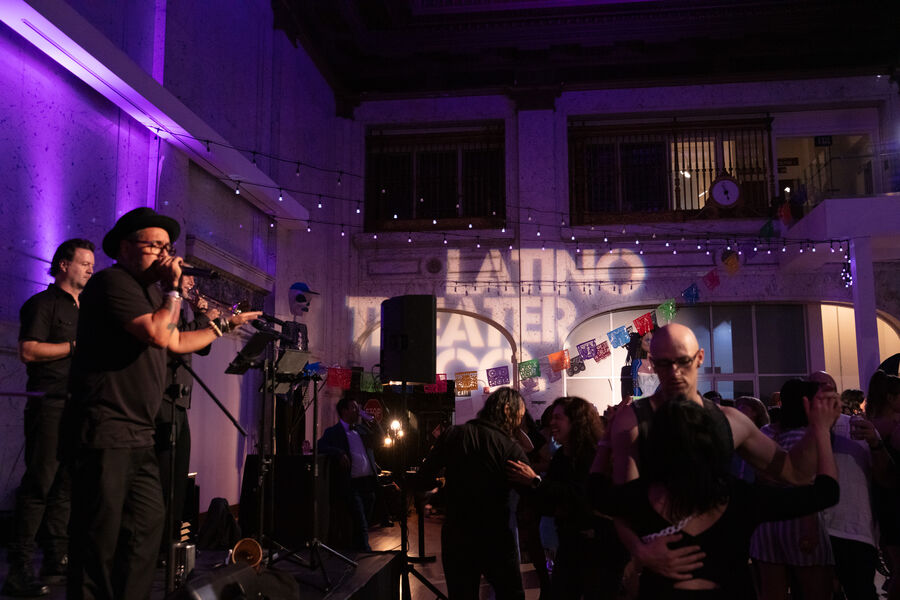
“There is no space in the American theatre for us,” artistic director José Luis Valenzuela said. Indeed, after attending his first TCG conference in 2011, he felt distraught about the lack of programming around Latine theatre and became determined to create that space on a national level. He requested a meeting with other Latine leaders, from which the Latinx Theatre Commons, a flagship of Howlround, emerged. Valenzuela was ready to take his own plunge with a national festival, aiming to gather theatremakers every three years.
This year’s Encuentro focused on presence and visibility, with the theme “We Are Here – Presente!,” and a grand total of 121 performances. However, Valenzuela said, calling it a festival wouldn’t be entirely accurate. It’s all about the exchange. Chican@s exchange contacts and laughter with Latin America-born artists; Spanish classics perform alongside queer protest art; and distinct hollers meld into one riotous melody.
Now partners in resistance, Encuentro and the Latinx Theatre Commons, which also hosts national convenings, have provided fertile ground for new art, relationships, and collectives. Valenzuela’s office alone proves the constellation-like reach of his efforts, with photographs, posters, and plays he midwifed—all of them titles I’ve followed since high school, seeing myself in the monarchs and monologues.
These are the places where migrant legends are born.
Not everyone has believed in the power of Latine theatre. Recalled Valenzuela of the first Encuentro in 2014, “Everybody thought we were insane. Everybody said nobody would come, and that one lasted a month. ‘No one will come to be in a festival for a month.’ I said, ‘That’s fine. Whoever comes will be part of this conversation.’ And everybody came! Everybody came, and we had such a great time, because this is what we want.”
Take just a few shows from the lineup. There was the breathtaking A Girl Grows Wings, a mostly non-verbal play centering a “Dreamer” (an undocumented immigrant brought to the U.S. as a child), written by Chicana playwright Marisela Treviño Orta and developed by Ciudad de México’s Organización Secreta Teatro. There was Austin-based Glass Half Full’s nightmarish Yamel Cucuy, the story of a girl detained and killed by ICE, then dragged through the levels of Mictlán (the Aztec underworld). There was the story of a journalist’s intimate road to recovery from significant memory loss and injuries after being forcibly silenced, in Rebeca Alemán’s The Delicate Tears of the Waning Moon from Chicago’s Water People Theater, a production strong and sure in its stillness.
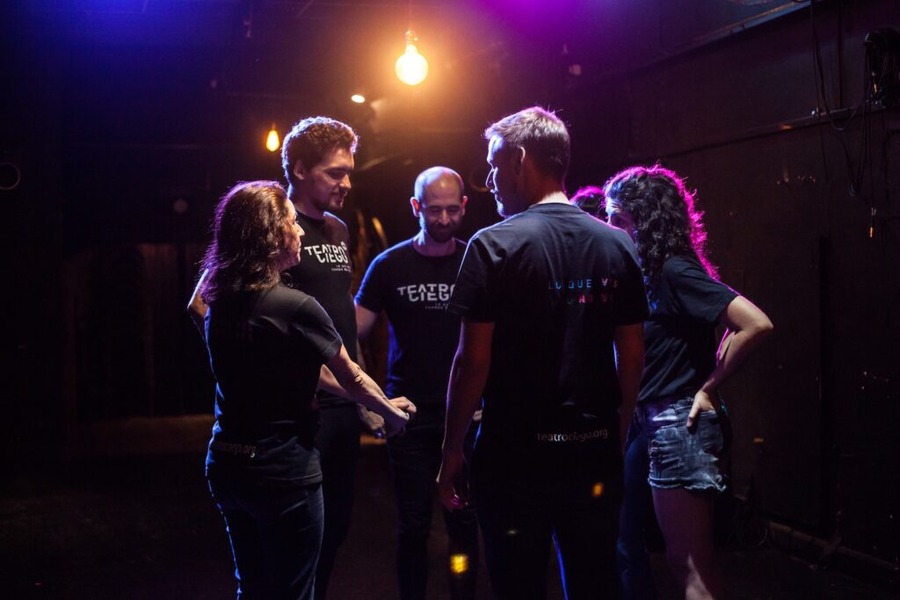
Or consider Pitchblack Experience’s luminous Odd Man Out, an aural show performed in complete darkness about a blind refugee musician fleeing Argentinian dictatorship. Disorienting, focused, loud, quiet, delicate, furious, loving, and above all true—you could find this and more on various stages.
Odd Man Out director Carlos Armesto affirmed how each company and project cultivates its own creative approach—and how much we need that diversity of process. Pitchblack premiered its work in Buenos Aires and has adjusted with each new space.
Performing in the dark, the actors must trust one another and their other senses. At the top of the rehearsal process, Armesto said, “We start off with a training session, so everybody gets trained in how to move and trust each other in the dark. Then after we have a sense of common vocabulary, we do typical text analysis. We sit there, read the play, turn it up, and then we start blocking it in light. Then we start really getting it after we have a sense of the story. Acting comes later. It’s really the logistics. When we actually start putting it together, we go into the dark and we really start moving around.”
The piece expanded my imagination around the extent to which the theatre can enable you, for under two hours, to live in another person’s shoes. I left not just spellbound by the story of survival, but with a greater awareness of my senses and appreciation for how others might experience the world.
While logistics and words took centerstage in Odd Man Out, a play like A Girl Grows Wings (known in Spanish as Alma Migrante) found strong footing in the non-verbal world. In fact, Marisela Treviño Orta shared that her script was only 12 pages long, and that much of the movement-heavy show was devised in community between the playwright and ensemble. She described those pages as “artifacts” of the production. When other theatres stage the play, she said she plans to provide them with an additional modified draft that empowers them to create their own physical versions of the original. Valenzuela, who commissioned Treviño Orta as a Latino Theater Company Imaginista, spoke about his commitment to developing work on the writers’ terms.
“What works for you doesn’t work for everybody else—I don’t think there is one way to create,” he said. When Treviño Orta told him she wanted to write “a play with no words,” they put their heads together to forge a fruitful collaboration. When they realized Organización Secreta Teatro would be ideal collaborators, Treviño Orta found herself, director Rocío Carrillo, and the ensemble in their own mini-encuentro, exchanging stories and creativity across borders. Treviño Orta shared that some of the Mexican artists didn’t know about “Dreamers” and their experiences in the U.S., and that they found themselves investigating the differences between Mexican and Chicano aesthetics. “Both of them needed to learn from each other,” said Valenzuela. “They did a Chicano play with a Mexican sensibility.”
The layered hybridity of migrant experience proved a hot topic throughout the Encuentro. Unlike previous years, several Spanish-speaking-only companies participated. That meant theatre staff ran projections to display English subtitles for plays in Spanish, Spanish subtitles for plays in English, and a mix of both for bilingual plays.
Dialogue abounded over live translations and subtitles for various languages and reasons. Some felt that a Spanish-only space was, in and of itself, a space of resistance. They wondered whether Spanish-to-English subtitles were always necessary. Couldn’t it provoke empathy for some audiences to understand what it’s like not to understand?
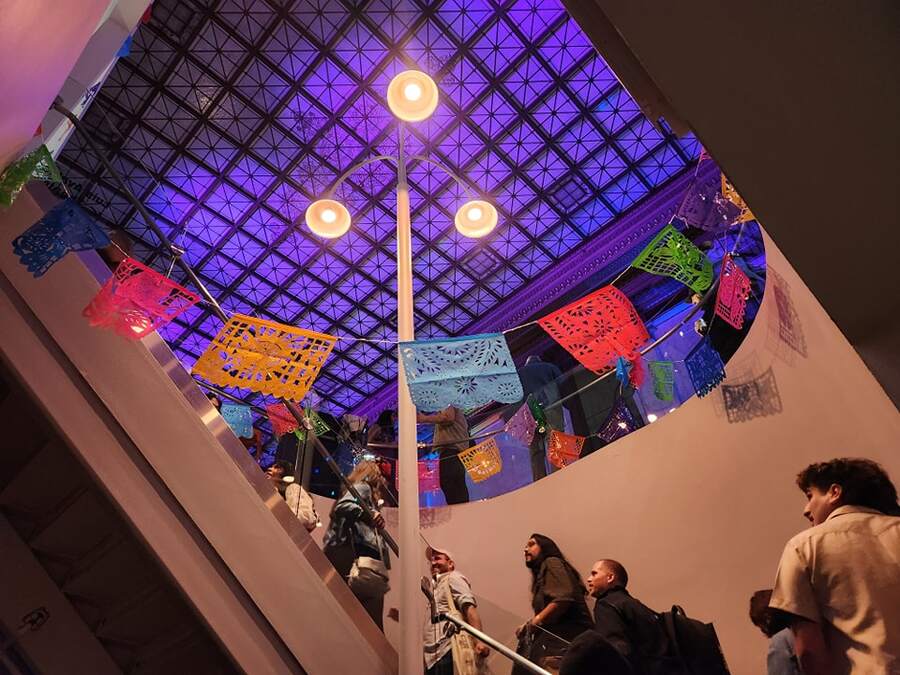
Some voiced how torn they felt about speaking English within a Latine collective. Others uplifted the experience of the “no sabo” kid. “How do we account for this in-between-ness?” one artist posed to the group.
Many noted that both languages are colonizer tongues and hence appreciated the plays that spoke to Latin American Indigeneity in the Nahuatl language. When it came to Portuguese, there was only one Brazilian theatre in attendance, New York’s Grupo.BR. Andressa Furletti, the theatre’s co-founding artistic director, and I shared accounts of the U.S.’s growing Brazilian population, and how media and culture haven’t caught up to represent us.
“Tenemos la capacidad,” said Iraida Tapias of Water People Theater, of insisting on our own languages, and considered the alternative: “If we cannot have spaces to speak our languages, how will we have the right to be here?”
Disagreements and grapplings brimmed with catharsis and love. In the name of presenting a united front, we rarely get to be so nuanced, full, and conflicted. In a festival of diversity, our individuality could bubble over, and the solidarity became more truthful. Chican@s and Latin Americans could embrace one another’s stories and, in doing so, learn more about themselves. As one 16-year-old Chicana put it after a student matinee, “They’re showing our history. I can envision myself in the characters.”
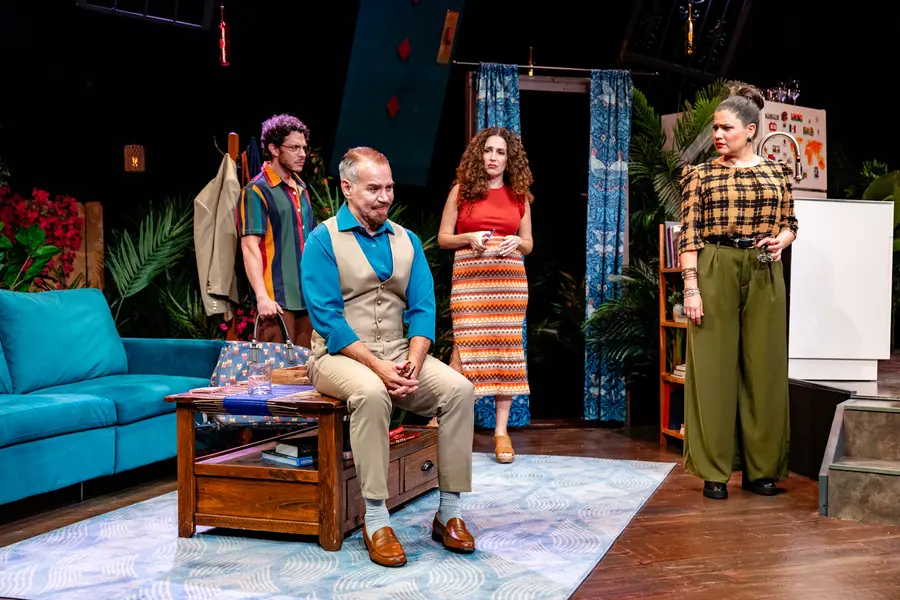
A moment I keep coming back to remains the heartfelt end of Las 22+ bodas de Hugo (The 22+ Weddings of Hugo Multiple), a production by D.C.’s GALA Hispanic Theatre. In the play, written by Gustavo Ott, an American man marries dozens of people, enabling whole families to stay together and prosper in the U.S., which the show calls “a beautiful crime.” The script doesn’t demarcate a breaking of the fourth wall, but under José Zayas’s direction, the title character stepped out of the scene, looked around at us in the theatre with a soft smile, as if showing us in real time his line: “Aquí cabemos todos.”
Here there is room for us all. The theatre became a country.
Even this diverse lineup of shows shared commonalities: key moments of silence, movement, and endings with direct audience calls-to-action. Fear crept in too, but again and again creatives combatted the infection. Some were more subtle, and others threw caution to the wind with their bold bravery. Luis Ordaz Gutiérrez’s jaw-dropping Cabarex 2: RevoLUZiones (ProyectoTEATRO of Austin), for instance, wasn’t afraid to rip apart oppressors across 500 years of Latin American history in comedy and drag. Onstage, our gods’ fight against Uncle Sam at the border didn’t look too different from the fights of half a millennium ago.
“Should borders exist?” one teen asked during a Yamel Cucuy post-show panel. “They don’t exist,” the creatives responded, recounting histories of shifting borders as mere penciled lines on a map. Or, as a character in Antigona 3.0 (Borderlands Theater of Tuscon, Arizona) put it, “Our bones belong here.”
Our artists and our gods have been working overtime. But still there must be space to dance. In the multitudes at Los Angeles Theater Center’s refuge, it wasn’t all trauma or “proving” ourselves; each evening artists grabbed drinks or danced to live music in the lobby.
These conversations weren’t the only encounters among creatives. As at previous Encuentros, the Latino Theater Company put participating artists into groups, empowering them to collaborate across companies, geographical borders, and languages. I got to see the result on the final day in performances that centered the sacred power of togetherness and solidarity—antidotes to any challenge.
Carola García López’s contribution resounded in particular, as she stood among an ensemble of performers who extracted and exploited her, then begged her to save them, in a parallel to Mother Nature. Also writer, director, and star in Teatro Público’s Blanco Temblor from Puerto Rico, García López spoke frequently and resonantly throughout the three weeks of Encuentro. Toward the end of her group’s devised performance, she spoke a poem, “Estamos viviendo en tiempos sombríos.” We are living in dark times. Then the actors linked hands.
Mauricio Marte, a Pitchblack artist, later responded to García López’s poem in a share-out, “We’ve been talking about living in the dark. And as someone who works in the dark, I know even the smallest light is so bright.” I recalled his play: The majority of Odd Man Out unfolded in a darkness so deep, I couldn’t tell if my eyes were open or closed. At the end of the play, the actors lit a single candle, and the audience gasped: Suddenly you could see everything.
I could see more clearly at Encuentro than I have in a while. I participated in many conversations among artistic leaders around sharing resources, banding together as international artist visas become all the more challenging to procure, angling for foundation support as the government increasingly turns its back on the arts, and creating new global meet-ups and collectives.
There will be much to write about in the coming months—not only of fear but of resistance. As developments strike each day, with compounding threats of mass deportations and censorship, we, a vital people and culture in this country, are not going anywhere.

When infection strikes, white blood cells join in coalition. Solidarity is simple, empirical, natural. Writing it is not. How do you reconcile the feelings of fear and hope in a people’s soul? How do you fit lifetimes into a play or article? Carry countries in your pocket? Convince others of the value of your freedom?
Encuentro’s spirit reminds us to live and create, presente. Mira una escena del último día: Facing questions without answers, José Luis Valenzuela takes one good look around the lobby as tired but fierce faces gasp for breath. Attendees hold one another, hands on backs, smiles through tears, cheering and lamenting the close of this encounter. Bracing for whatever comes next for our people. Valenzuela suspends his fist in the air, as if he’s never put it down for his over 30 years in the business. His smile has resisted each blow and survives yet again, warm like a family member, prescient like a prophet, as he repeats in triumph, “¡Sí, se puede!”
Gabriela Furtado Coutinho (she/her) is the digital editor of American Theatre.
Support American Theatre: a just and thriving theatre ecology begins with information for all. Please join us in this mission by joining TCG, which entitles you to copies of our quarterly print magazine and helps support a long legacy of quality nonprofit arts journalism.

